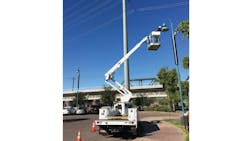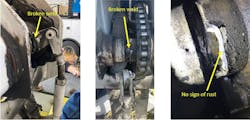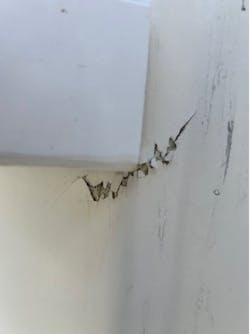Work Truck Roundup: Bucket truck maintenance
For more specialized work truck maintenance:
Whether repairing powerline damage after a storm or car accident, utility trucks are called upon everywhere and every day to help power homes and businesses. And when that time comes, they need to be ready.
But what do they need to do their critical job? We connected with Sean Mason, general manager for Altec Service; and Hector Varela, fleet supervisor for San Antonio-based CPS Energy, to find out.
A life in the sky
For context, Altec provides several kinds of aerial lift trucks, including non-overcenter, overcenter, telescopic, and telescopic articulating trucks, for which Altec Service can provide maintenance and repairs.
CPS uses several of those trucks, including those that reach up to 36’ and 40’, as well as Terex’s LT40 bucket truck, TC55 bucket truck, TM125 Transmission bucket truck, and more. This variety is due to the many kinds of jobs CPS handles, from substations to highline work, with each requiring the right bucket truck for the job.
“Combined, we have about 212 bucket trucks that are spread out through five districts,” said Varela, who was recognized last year as a Fleet Maintenance Overachiever of the Year.
It helps that bucket trucks tend to have relatively long lifespans, with Varela noting that their trucks tend to last about 10 years. But according to Mason, they design their trucks to last even longer, up to around 15 years of normal use.
This is even with the general wear and tear working vehicles tend to pick up, from wearing out tires, batteries, and brakes, to the specific wear that the truck booms see.
“On the boom side, we tend to find hydraulic leaks, cylinders, leaking pins that are worn, leveling rods that are worn, and sprockets,” Varela explained.
And this wear and tear does need to be handled consistently and quickly, due to the danger improper maintenance can add to utility workers’ roles. As an example, Mason said that in harsher environments, compromised paint can lead to rust, and if techs don’t handle the proper torque checks on the rotation bearing structure, that can be compromised too.
“Ultimately, the uptime of the equipment and operator safety might be compromised if maintenance is neglected,” Mason said.
Inspections and pre-flight checks
For an industry focused on safety, this makes thorough inspections critical, as is following manufacturer recommendations when it comes to regular maintenance, Mason explained. These can include greasing, visual inspections, systems and control checks, checking the torque on specific fasteners, and dielectric testing.
At CPS, Varela said the company takes care of both monthly and quarterly inspections, depending on the unit. “We also have a third party that comes in and completes our yearly inspection,” he added. “With the yearly inspections, they do the dielectric test at that point.”
Truck operators are also required to check their boom alignment, trucks, and tools regularly, and let their garage know if anything seems amiss.
As for the booms specifically, technicians and operators check their operation for hazards, make sure that there are no leaks or cracks in the bucket itself or the pedestal underneath it, and ensure that the fasteners are correct and tight.
They also “Make sure all the inspection covers and warning labels are present,” Varela said. “Warning labels are a big item, you [have to] make sure that all that’s good and readable. Also, safety devices, like interlock switches, are a big one.” Safety devices also include making sure a truck’s safety alarms, which go off when an outrigger is descending, are operational, too.
Of course, then there’s checking the trucks for any damage as well, particularly in the undercarriage. There, Varela said technicians check the driveline and brakes for any leaks, as well as the air system, and any other leaks on the engine, transmission, and PTO. The inside of the boom needs to be checked for oil leaks too, especially since sometimes, animals try to make their homes inside the crane arm.
“Birds and critters tend to get in these booms, just to stay warm,” Varela explained. “We've had raccoons. We've had mice, squirrels.”
And while the creatures might be cute, the damage they can do is not. In one instance, Varela said that a squirrel chewed the coating off of some hydraulic lines, using it to build a nest.
“If we didn't inspect this unit and we let it go out, this could have led to a lot of issues springing up, [like with] a major leak, the operator [could be] stuck in the air,” he said.
To make sure that other garages are on the lookout, Varela said that CPS even puts out a safety alert to other locations when they find an issue during preventative maintenance.
Training for takeoff
With the sheer amount of aerial devices that any fleet may have, proper training is a must for technicians servicing these trucks and the operators using them.
For technicians, Mason said that having a basic understanding of hydraulics and other systems is critical for diagnostics and troubleshooting. It’s also important that technicians know what tools to use and when.
For instance, while all tech know that lubrication is key for most trucks, “using the proper product that the unit calls for is key,” Varela emphasized, as is knowing how much grease to apply. “We’ve done well over the years, but years ago, we saw [equipment that] wouldn’t take grease or people were overstepping grease fittings, and it’d lead to other issues.”
Operator training is important, too, as Varela recalled that when CPS transitioned from one of Terex’s trucks to another, they required a different process to properly cradle the boom. But because linemen were used to their old ways, that led to some cracked buckets, which CPS would typically have to send back to the manufacturer.
Ultimately, both Mason and Varela stressed that between proper maintenance and inspections, their ultimate focus was on safety for the operator, from the moment their feet left the ground to when they returned to earth.
“At the end of the day, we want these units to go out, be on the road, and be safe,” Vaerla asserted. “We want the operators to feel the comfort that they're safe while operating these units and get back home to their families.”
About the Author

Alex Keenan
Alex Keenan is an Associate Editor for Fleet Maintenance magazine. She has written on a variety of topics for the past several years and recently joined the transportation industry, reviewing content covering technician challenges and breaking industry news. She holds a bachelor's degree in English from Colorado State University in Fort Collins, Colorado.



